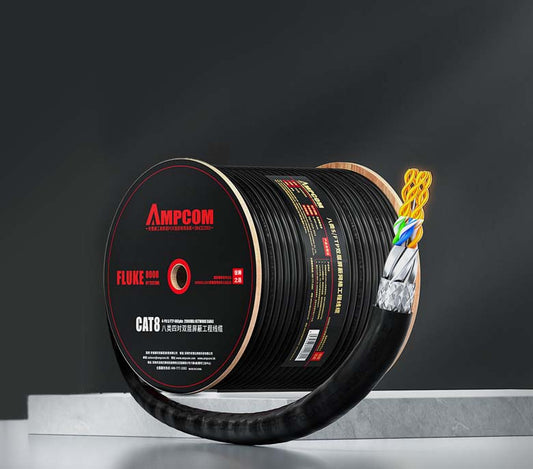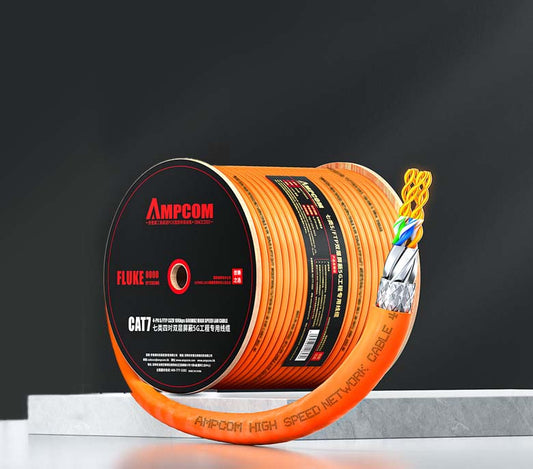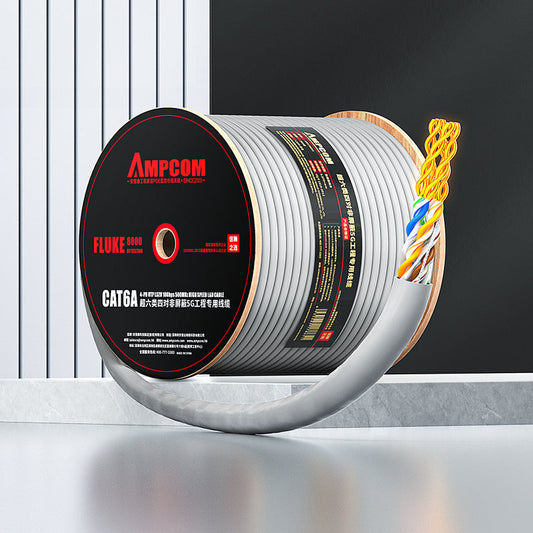More Than Just Speed! Fiber Optic Networks Unlock New Possibilities for Your Digital Life
In the digital age sweeping across the globe, the internet has become an indispensable part of our daily lives. From the early days of dial-up connections to today's broadband networks, the continuous improvement in internet speed has allowed us to witness the charm of technological advancement. Among these developments, the emergence of fiber optic networks is not merely a leap in speed, but rather a gateway to a brand new realm of digital living, offering unprecedented experiences and boundless possibilities.

The Perfect Blend of Speed and Stability in Fiber Optic Networks
Fiber optic networks, as the name suggests, utilize light pulses transmitted through optical fibers to carry data. Compared to traditional copper cable networks, fiber optic networks offer numerous advantages. From a technical perspective, the transmission speed of optical fibers can reach tens or even hundreds of gigabits per second, far exceeding that of traditional copper cable networks. For instance, common fiber broadband packages today can offer download speeds of 500Mbps, 1000Mbps, or even higher. This means downloading a high-definition movie can be accomplished in just a few minutes, whereas traditional broadband might take dozens of minutes or even longer.
Moreover, the stability of fiber optic networks is also exceptional. Optical fibers are immune to electromagnetic interference and experience minimal signal loss during transmission, ensuring the stability and reliability of data transfer. In traditional copper cable networks, electromagnetic interference can lead to degraded signal quality, causing issues like disconnections and buffering. Fiber optic networks, however, effectively avoid these problems, providing users with a seamless online experience. For example, in areas with complex electromagnetic environments, such as large shopping malls or industrial zones, fiber optic networks maintain stable performance where traditional networks might struggle.
Technical Parameters Highlighting the Superiority
Let's delve into some key technical parameters that underscore the advantages of fiber optic networks:
- Bandwidth Capacity: Fiber optic cables can support bandwidths ranging from 10 Gbps to 100 Gbps, and even higher, with research pushing towards Terabit-level speeds. In contrast, typical copper cables max out at around 1 Gbps.
- Signal Transmission Distance: A single optical fiber can transmit signals over distances of up to 100 kilometers without needing repeaters, whereas copper cables usually require amplification every few hundred meters.
- Latency: Fiber optic networks generally offer lower latency (the delay between sending and receiving data) compared to copper networks, often measured in single-digit milliseconds for local connections, which is crucial for real-time applications like online gaming and video conferencing.
- Interference Resistance: As mentioned, optical fibers are not affected by electromagnetic fields, ensuring data integrity even in noisy environments. Copper cables are susceptible to interference from nearby electrical equipment, power lines, and even radio waves.
- Data Security: It's significantly harder to tap into an optical fiber without detection compared to copper wires, enhancing the security of data transmission.
These parameters collectively illustrate why fiber optic networks represent a fundamental upgrade over traditional broadband infrastructure.

Empowering the Smart Home Ecosystem
One of the most tangible benefits of fiber optic networks is their ability to power sophisticated smart home ecosystems. Modern homes are increasingly becoming interconnected hubs where various devices communicate and collaborate to enhance convenience, security, and energy efficiency. Fiber optic networks provide the robust backbone necessary for this interconnectedness.
Example: The Fiber-Powered Smart Home
Imagine a typical day in a home equipped with a high-speed fiber connection. As you wake up, your smart alarm clock, connected to the network, signals your smart blinds to gradually open, letting in natural light. Your coffee maker, which you pre-programmed via a mobile app the night before, starts brewing. Simultaneously, your smart thermostat adjusts the temperature based on the weather forecast and your usual preferences, all transmitted seamlessly over the fiber network.
Throughout the day, you can control your home's lighting, security cameras, door locks, and entertainment systems from anywhere using your smartphone or through voice commands to a smart assistant. All these devices require a stable and fast internet connection to function optimally, and fiber optic networks deliver exactly that. The low latency ensures that commands are executed almost instantaneously, and the high bandwidth allows multiple devices to operate concurrently without any lag.
For instance, if you're watching a high-definition movie in the living room while your partner is video calling a client in the home office, and your kids are playing online games in their rooms, a fiber network handles all these data-intensive activities simultaneously without any degradation in performance. This level of seamless integration and performance is what truly defines the smart home experience enabled by fiber.
The integration goes beyond basic convenience. Advanced smart home systems can analyze usage patterns to optimize energy consumption, enhancing sustainability. Security systems become more responsive, with high-definition cameras providing clear footage and smart sensors alerting you to any unusual activity in real-time. All these capabilities rely heavily on the high-speed, low-latency data transmission that fiber optic networks provide.

Revolutionizing Entertainment: HD Streaming, Cloud Gaming, and VR/AR
The entertainment landscape has been dramatically reshaped by digital technology, and fiber optic networks are at the heart of this revolution. High-definition streaming, cloud gaming, and immersive Virtual Reality (VR) and Augmented Reality (AR) experiences demand significant bandwidth and minimal latency, requirements that fiber networks meet with ease.
High-Definition Live Streaming
Live streaming has become a dominant form of entertainment and information sharing. Whether it's watching sports events, concerts, educational webinars, or interactive gaming streams, viewers expect high-quality, uninterrupted experiences. 4K and even 8K streaming, which offer incredibly sharp and detailed visuals, require substantial bandwidth. A standard 4K stream can consume anywhere from 15 to 25 Mbps, and 8K can require 50 Mbps or more. Fiber optic networks, with their multi-gigabit speeds, can handle these data demands effortlessly, ensuring that every frame is delivered smoothly without buffering or pixelation.
Example: The Difference in Live Streaming Quality
Consider two viewers watching the same live 4K sporting event. One is connected via a traditional broadband connection with speeds around 50-100 Mbps, while the other is on a 1 Gbps fiber connection. The viewer on the traditional connection might experience occasional buffering, especially during peak usage times or if multiple devices are sharing the connection. The video quality might dip to 1080p or lower to compensate for the bandwidth limitations. In contrast, the fiber-connected viewer enjoys a consistently high-quality 4K stream, with every detail of the action crystal clear and the audio perfectly synchronized. This difference is not just about resolution; it's about the overall immersive experience that fiber enables.
Cloud Gaming: Gaming Without Boundaries
Cloud gaming is a paradigm shift where the heavy lifting of game processing is done on remote servers, and only the video output and input commands are transmitted to the user's device. This means you can play graphically intensive games on a simple laptop, tablet, or even a smart TV, as long as you have a reliable internet connection.
However, cloud gaming is extremely sensitive to latency. Even a few milliseconds of delay between pressing a button and seeing the action on screen can ruin the gaming experience, especially in fast-paced games. Fiber optic networks, with their inherently low latency, provide the ideal environment for cloud gaming. Services like NVIDIA GeForce NOW, Google Stadia (before its shutdown), Xbox Cloud Gaming (xCloud), and PlayStation Plus Premium all benefit immensely from fiber connections.

Technical Requirements for Cloud Gaming
For a smooth cloud gaming experience, certain technical parameters must be met:
- Download Speed: Generally, a minimum of 15-25 Mbps is recommended for 1080p gaming, while 4K gaming might require 35-50 Mbps or more.
- Upload Speed: While less critical than download speed, a stable upload speed of at least 1-3 Mbps is needed for transmitting input commands.
- Latency (Ping): This is the most crucial factor. For responsive gaming, latency should ideally be below 40 milliseconds, with 20-30 milliseconds being optimal. Fiber networks typically achieve these low latency figures.
- Consistency: The connection must be stable and free from significant fluctuations in speed or latency, which fiber networks excel at providing.
Without a fiber connection, the potential of cloud gaming remains largely untapped due to these technical constraints.
Immersive VR/AR Experiences
Virtual Reality (VR) and Augmented Reality (AR) are poised to transform how we interact with digital information and entertainment. VR creates fully immersive simulated environments, while AR overlays digital information onto the real world. Both technologies rely heavily on high-speed data transfer for several reasons:
- High Resolution and Frame Rates: VR headsets need to display high-resolution images at high frame rates (typically 90 frames per second or more) to prevent motion sickness and provide a truly immersive experience. This requires significant bandwidth for rendering and displaying content.
- Low Latency: Any delay between head movement and the corresponding change in the VR/AR view can cause discomfort or break the immersion. Fiber networks' low latency is essential for achieving this responsiveness.
- Cloud-Based Processing: More advanced VR/AR applications are moving towards cloud-based processing, where complex calculations are done remotely. This further increases the reliance on high-bandwidth, low-latency connections like fiber.
Example: VR/AR in Everyday Life
Imagine using a VR headset connected to a fiber network for a virtual tour of a historical site. The high bandwidth allows for detailed, lifelike 3D models and textures, making you feel like you're actually there. The low latency ensures that as you turn your head, the view updates instantly, maintaining your sense of presence. In an AR scenario, like using a smart glasses device for navigation, fiber ensures that real-time map data, points of interest, and route guidance are overlaid smoothly onto your field of vision without lag or interruption. These applications are not just futuristic concepts; they are becoming increasingly accessible, and fiber optic networks are the key enabler.

Enabling the Future of Work: Remote and Smart Office Solutions
The way we work is undergoing a significant transformation, with remote work and flexible office arrangements becoming increasingly common. This shift is not just a temporary response to external factors but a fundamental change in work culture. Fiber optic networks play a crucial role in making these new work models viable and productive.
Remote work relies heavily on digital communication and collaboration tools. Video conferencing, file sharing, cloud-based project management, and virtual desktops all demand robust internet connectivity. A slow or unreliable connection can lead to frustrating delays, dropped calls, and difficulty accessing necessary resources, hindering productivity.
Example: The Remote Worker's Advantage
Consider a team of professionals working remotely for a global company. They rely on high-definition video conferencing for daily stand-ups and client meetings. With a fiber connection, the video calls are clear and stable, allowing for effective communication as if everyone were in the same room. Large design files or reports can be shared instantly, and cloud-based applications run smoothly without lag. This seamless connectivity fosters collaboration and ensures that remote team members can contribute effectively, regardless of their physical location. In contrast, a team relying on slower broadband might experience constant buffering during calls, struggle to upload large files, and face delays in accessing cloud resources, leading to frustration and reduced efficiency.
Furthermore, the concept of the "smart office" is gaining traction. Even physical office spaces are becoming more connected and automated, leveraging Internet of Things (IoT) devices for enhanced comfort, security, and efficiency. Smart lighting, climate control systems, access control, and occupancy sensors all require a reliable network backbone. Fiber optic networks provide the necessary capacity and stability to support these interconnected systems, creating a more productive and sustainable work environment.
For businesses, investing in fiber optic network solutions is not just about improving employee satisfaction; it's about maintaining competitiveness in an increasingly digital and flexible economy. It allows companies to attract talent regardless of location, reduce overhead costs associated with large office spaces, and foster a culture of innovation and collaboration.
A Glimpse into the Future: The Fiber-Powered Lifestyle
As we look ahead, the role of fiber optic networks in shaping our daily lives will only continue to grow. They are not just a faster version of existing technology; they are the foundational infrastructure upon which the future of digital living is being built. Let's paint a picture of what this future might look like:
- Seamless Integration: Your smart home is fully integrated with your health monitoring devices, your car, and your workplace. Your morning routine is optimized based on your sleep patterns, traffic conditions, and your work schedule, all orchestrated by your fiber-connected home hub.
- Hyper-Personalized Entertainment: Entertainment is no longer passive consumption but an interactive experience. You can jump into your favorite movie's world via VR, interact with characters, or even influence the plot. Live events become fully immersive, allowing you to choose your perspective or access behind-the-scenes content in real-time, all streamed flawlessly via fiber.
- Ubiquitous Cloud Services: Your entire digital life resides in the cloud, accessible from any device, anywhere. You can collaborate on complex projects with colleagues across the globe as if you were in the same room, thanks to ultra-low latency fiber connections. Education becomes more immersive and accessible, with virtual classrooms and hands-on training simulations powered by cloud computing and fiber networks.
- Enhanced Realities: AR becomes a seamless part of daily life. You get real-time information about your surroundings, navigate effortlessly, and interact with digital objects overlaid on the physical world. VR creates new forms of social interaction, entertainment, and even therapy, all supported by the high-speed, reliable backbone of fiber.
- Efficient and Sustainable Cities: On a larger scale, fiber networks enable smart city initiatives. Traffic lights adjust in real-time based on traffic flow, energy grids optimize distribution, and public services become more responsive and efficient, all powered by the data highways of fiber optic cables.
This future is not science fiction; it's being built piece by piece, and fiber optic networks are the essential threads connecting it all. They are the invisible infrastructure that makes these advanced applications not just possible, but practical and enjoyable.

Summary: Fiber Networks as the Key to Unlocking Digital Potential
The narrative around fiber optic networks needs to move beyond the simple metric of speed. While their multi-gigabit capabilities are impressive, the true value lies in what that speed and stability enable. We've explored how fiber networks are the indispensable backbone for the modern smart home, delivering seamless automation and control. We've seen how they revolutionize entertainment through flawless HD streaming, responsive cloud gaming, and immersive VR/AR experiences, each demanding high bandwidth and minimal latency. Furthermore, fiber is proving essential for the future of work, facilitating productive remote collaboration and powering the intelligent smart office environments of tomorrow.
These applications are not isolated examples; they represent the convergence of technology that defines our digital age. From the comfort of your home to the flexibility of your workspace, and from the way you entertain yourself to how you interact with the world, fiber optic networks are the enablers, the facilitators, the silent partners in progress. They are more than just a utility; they are the key that unlocks a new dimension of digital living, offering convenience, efficiency, and experiences previously unimaginable.
Understanding the comprehensive value of fiber – its role in enabling innovation, enhancing quality of life, and future-proofing our digital infrastructure – is crucial. It's not just about having a fast internet connection; it's about having the foundation for a richer, more connected, and more efficient life.
Ready to unlock the full potential of your digital life? Explore our fiber broadband packages and tailored fiber optic network solutions for your smart home or smart office needs today!



